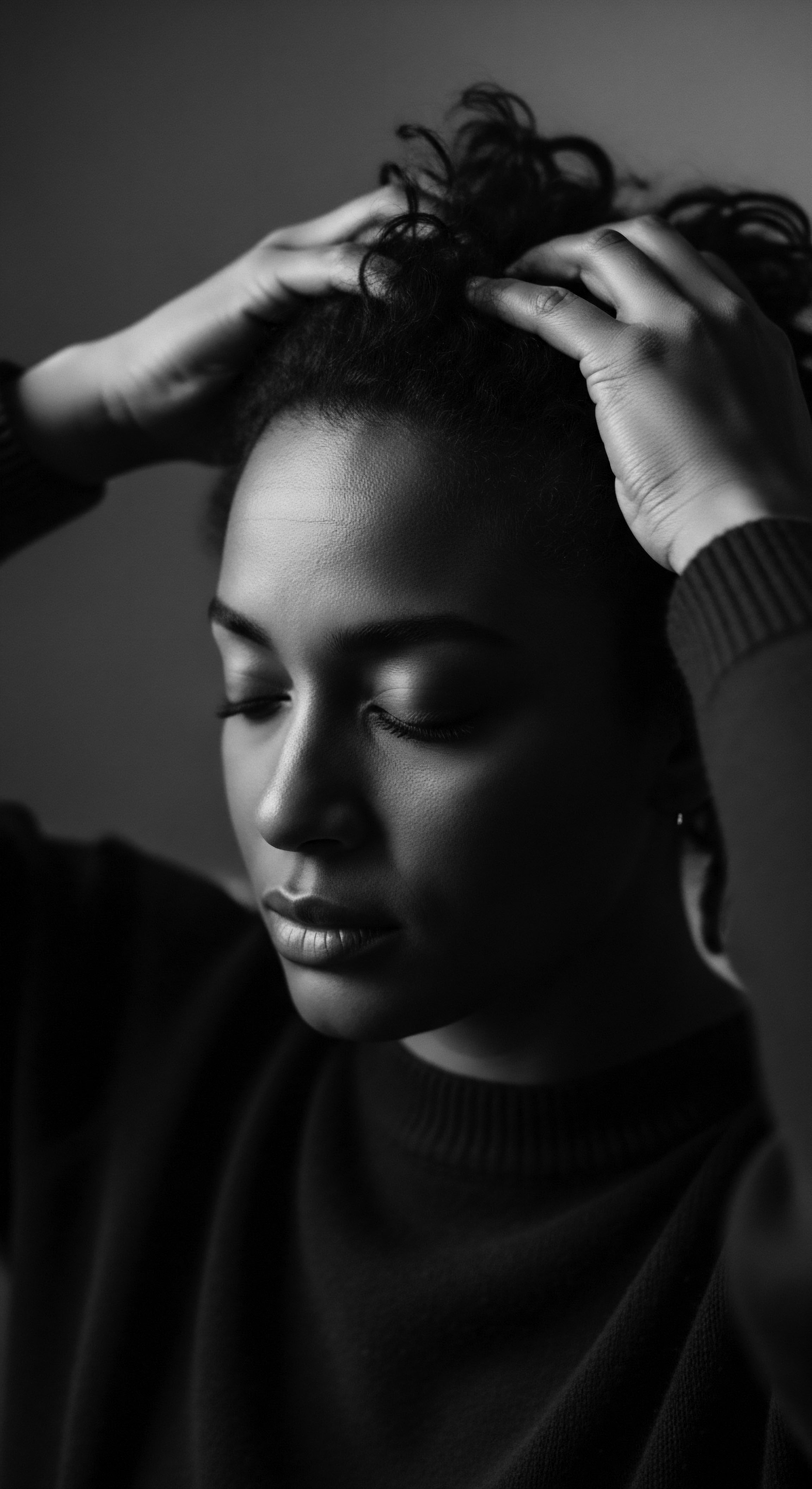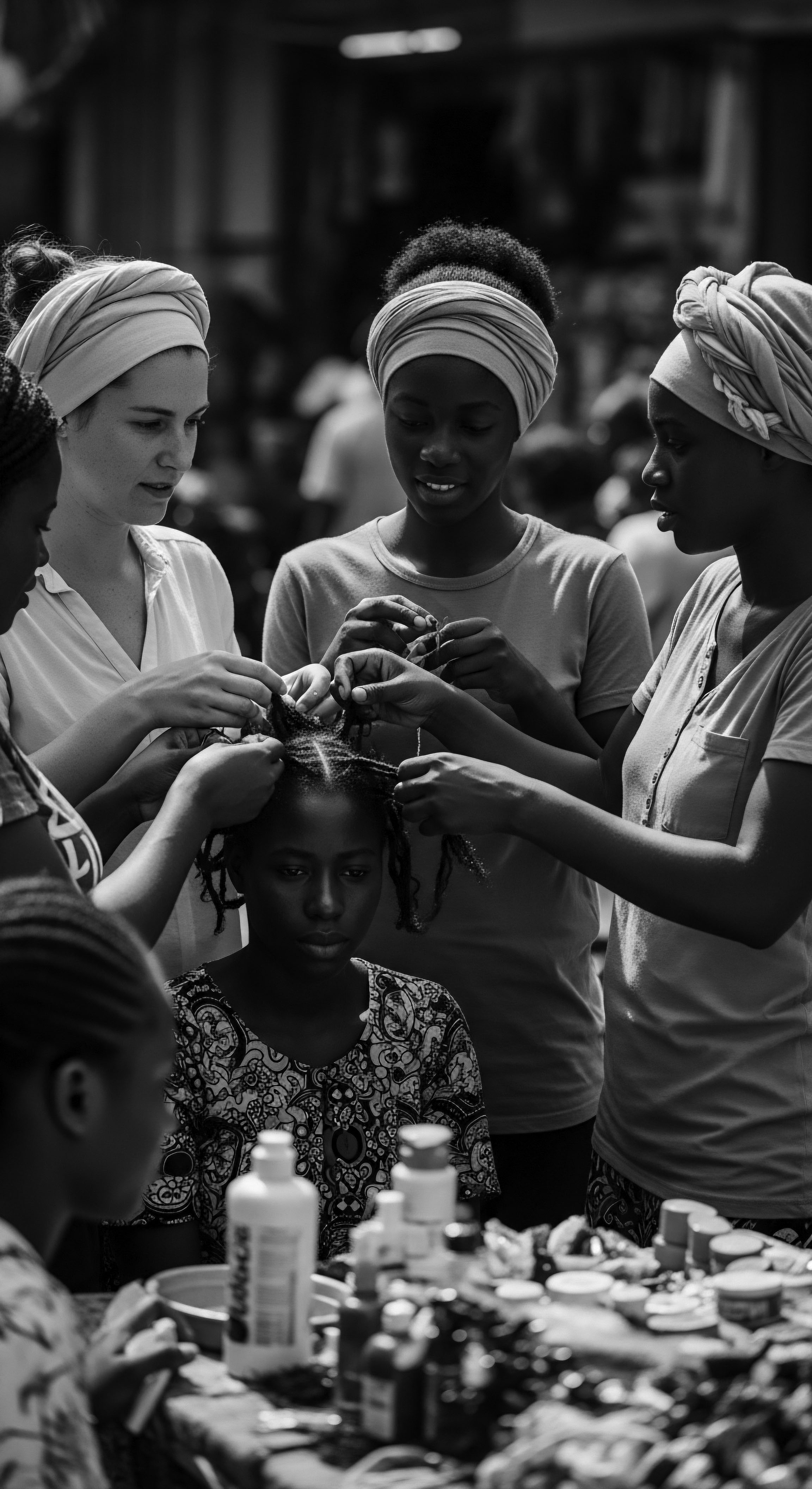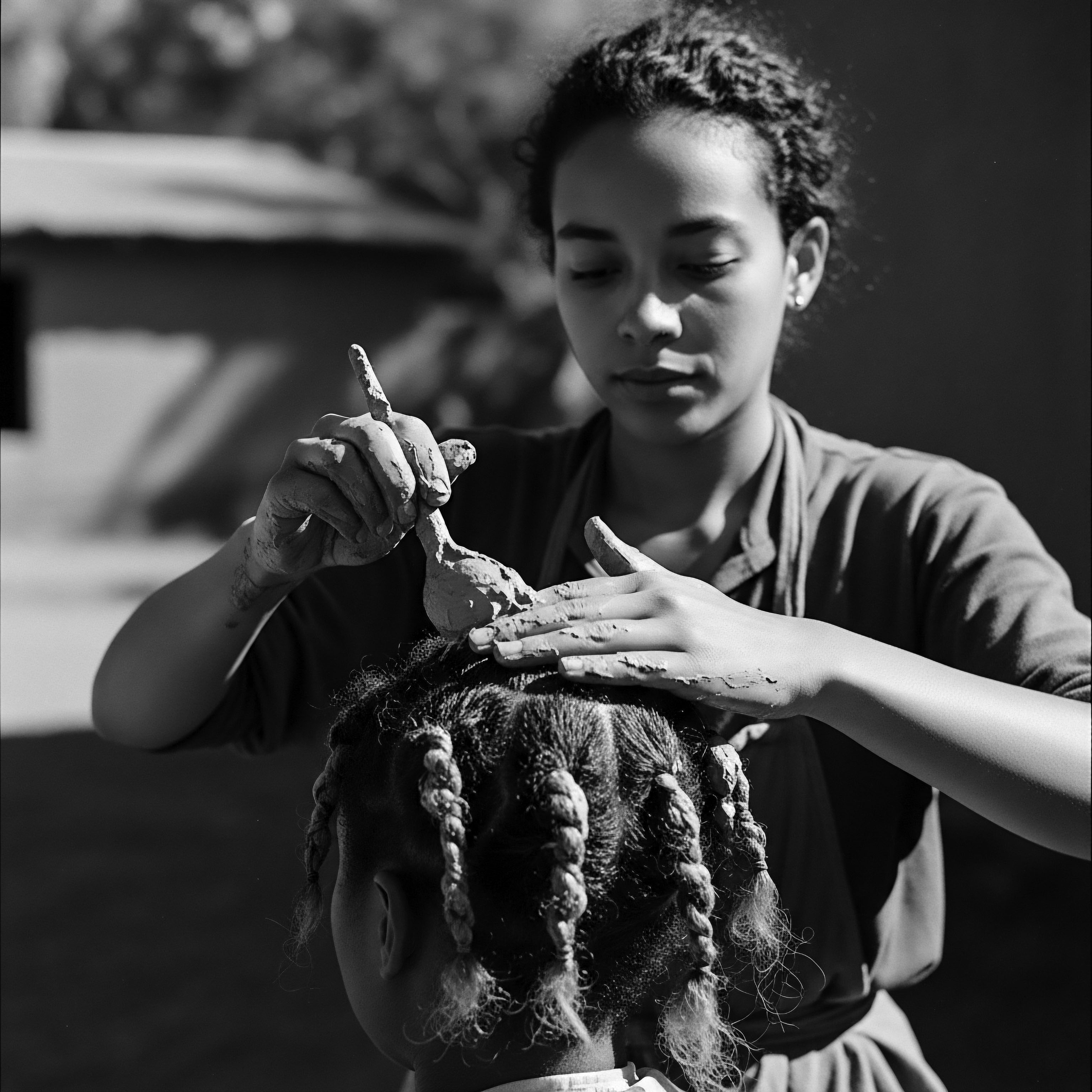
Fundamentals
The study of Cosmetic Science, at its most fundamental, concerns itself with the creation, formulation, and evaluation of products designed to cleanse, protect, and beautify the human body. This field draws upon a diverse array of scientific disciplines, including chemistry, biology, physics, and dermatology, to understand the interactions between ingredients and biological substrates, such as skin and hair. The core aim is to enhance appearance and maintain well-being, yet its historical trajectory and cultural interpretations are far from uniform, particularly when we consider the vibrant heritage of textured hair.
For those new to this intricate domain, Cosmetic Science can be understood as the systematic investigation into how various substances can be combined to achieve specific aesthetic or protective outcomes. It encompasses everything from understanding the molecular structure of a hair strand to designing a product that delivers moisture effectively. The definition of this field extends beyond mere superficiality; it is an exploration of material science applied to human adornment and care, with a deep, often unspoken, connection to identity and communal practices.
Consider, for a moment, the simple act of cleansing hair. From a fundamental Cosmetic Science perspective, this involves surfactants interacting with oils and dirt to lift them from the hair shaft and scalp. However, the choice of cleanser, its pH, and its conditioning agents are all carefully considered to prevent damage, especially to delicate textured strands. The explication of these basic principles reveals a world where scientific rigor meets the everyday rituals of personal care.
Cosmetic Science fundamentally explores the creation and effects of beauty products, deeply intertwined with cultural practices and ancestral knowledge, especially for textured hair.
The initial understanding of Cosmetic Science, therefore, is not merely about ingredients on a label, but about the profound relationship between human ingenuity and the body’s natural expressions. It is a clarification of how we have, through the ages, sought to enhance our physical presence, often with profound cultural underpinnings.
A primary concern within this foundational understanding is the physical makeup of hair itself. Hair, regardless of its texture, is primarily composed of keratin, a protein. The unique coiling patterns of textured hair—from loose waves to tight coils—are a result of the distribution of disulfide bonds and the shape of the hair follicle. Cosmetic Science seeks to comprehend these biological realities to formulate products that respect and work harmoniously with these inherent structures, rather than against them.
- Keratin Structure ❉ The fundamental protein that forms hair, influencing its strength and elasticity.
- Disulfide Bonds ❉ Chemical links within keratin that largely determine the hair’s natural curl pattern.
- Hair Follicle Shape ❉ The shape of the follicle dictates the cross-sectional shape of the hair strand, directly impacting its curl.

Intermediate
Stepping beyond the elemental understanding, the intermediate interpretation of Cosmetic Science delves into the sophisticated interplay of formulation, stability, and consumer perception, always viewed through the lens of hair heritage. This level of inquiry recognizes that a cosmetic product is not merely a collection of chemicals, but a carefully orchestrated system designed to deliver specific benefits while addressing the unique needs and historical contexts of its users. The significance of this field for textured hair communities cannot be overstated, as it speaks to generations of innovation and adaptation.
At this stage, Cosmetic Science begins to truly appreciate the historical legacy embedded within hair care practices. Consider the traditional use of natural oils and butters in African and diasporic communities for centuries. These ancestral practices, often passed down through oral traditions, were, in essence, early forms of cosmetic science.
They were rooted in keen observation of how plant extracts interacted with hair and scalp, providing moisture, protection, and promoting vitality. The explication of these historical precedents reveals a continuity of knowledge that bridges ancient wisdom with contemporary scientific understanding.
For instance, the use of Shea Butter (Vitellaria paradoxa) in West African communities for skin and hair care stands as a powerful example of traditional cosmetic science. It was, and remains, valued for its emollient properties, providing intense moisture and sealing the hair cuticle, thereby reducing breakage in textured strands. This traditional knowledge, now often validated by modern analytical techniques, highlights a deep, inherited understanding of ingredient efficacy.
Cosmetic Science, at an intermediate level, explores the intricate relationship between product formulation and the diverse historical hair care practices that have shaped textured hair heritage.
The meaning of Cosmetic Science at this level also involves understanding the challenges and innovations that have emerged from the textured hair experience. The historical pressures to conform to Eurocentric beauty standards often led to the widespread use of harsh chemical straighteners, known as relaxers. These products, while offering a desired aesthetic, fundamentally alter the hair’s protein structure by breaking its disulfide bonds, leading to potential damage and fragility (Khumalo et al. 2010).
This specific historical example powerfully illuminates the complex connection between Cosmetic Science, societal pressures, and the well-being of textured hair. The pursuit of straightened hair, driven by societal norms, inadvertently spurred scientific inquiry into the long-term effects of these chemical interventions, prompting a deeper investigation into hair biology and the development of less damaging alternatives.
The evolution of hair care products for textured hair reflects a dynamic interplay between ancestral wisdom, scientific discovery, and cultural shifts. From early formulations rooted in natural ingredients to the advent of chemical processes, and now, a resurgence of interest in natural hair care, the narrative of Cosmetic Science is rich with adaptation.
The intermediate perspective also acknowledges the intricate composition of modern cosmetic products. These are not just simple mixtures but complex emulsions, suspensions, and solutions, each ingredient chosen for a specific purpose:
- Surfactants ❉ Compounds that reduce surface tension, enabling cleansing and lathering.
- Emollients ❉ Ingredients that soften and smooth the hair, often plant-derived oils or synthetic esters.
- Humectants ❉ Substances that attract and retain moisture from the air, crucial for hydrating textured hair.
- Conditioning Agents ❉ Polymers or proteins that coat the hair shaft, reducing tangles and improving manageability.
- Preservatives ❉ Essential components that prevent microbial growth, ensuring product safety and longevity.
Understanding the significance of each component within a formulation, and how it contributes to the overall performance and safety of a product, forms a vital part of this intermediate exploration. It is a delineation of how scientific principles are applied to create products that genuinely serve the diverse needs of hair, particularly hair that carries the rich legacy of varied textures.
| Traditional Practice/Ingredient Shea Butter (Vitellaria paradoxa) as a sealant and moisturizer |
| Modern Cosmetic Science Link Validated for high fatty acid content, providing emollient and occlusive properties. |
| Traditional Practice/Ingredient African Black Soap (Ose Dudu) for cleansing |
| Modern Cosmetic Science Link Contains natural ash and plantain extracts, offering gentle cleansing and exfoliation. |
| Traditional Practice/Ingredient Hair Oiling with various plant oils (e.g. coconut, olive) |
| Modern Cosmetic Science Link Recognized for penetration into hair shaft, reducing protein loss and providing lubrication. |
| Traditional Practice/Ingredient Clay Masks (e.g. Bentonite, Rhassoul) for detox and definition |
| Modern Cosmetic Science Link Known for mineral content and adsorptive properties, clarifying and defining curl patterns. |
| Traditional Practice/Ingredient This table highlights the enduring wisdom of ancestral practices, often finding affirmation and deeper understanding through contemporary scientific inquiry. |

Academic
The academic definition and meaning of Cosmetic Science, particularly as it pertains to textured hair, transcends a mere technical description; it represents a profound, interdisciplinary inquiry into the biophysical properties of hair, the socio-historical forces shaping beauty standards, and the ethical implications of product development within a globalized context. This rigorous examination requires a nuanced understanding of advanced chemistry, molecular biology, and material science, alongside a critical engagement with cultural anthropology, historical studies, and public health. It is an intellectual pursuit that scrutinizes the very fibers of identity woven into each strand of textured hair.
From an academic standpoint, Cosmetic Science is the systematic application of scientific principles to the design, production, and evaluation of cosmetic formulations, with a specific focus on optimizing efficacy, safety, and consumer experience. For textured hair, this involves an in-depth analysis of its unique helical structure, the distribution of disulfide bonds, and the cuticle’s integrity, which collectively contribute to its distinct mechanical properties and susceptibility to damage. Researchers in this domain might investigate the kinetics of chemical reactions within hair relaxers, the rheology of styling gels on highly coiled strands, or the spectroscopic analysis of hair treated with various conditioning agents. The elucidation of these complex interactions requires sophisticated analytical techniques and a deep theoretical grounding in polymer science and organic chemistry.
One might consider the profound impact of Chemical Relaxers on the integrity of textured hair, a topic that has garnered significant academic scrutiny. These formulations, typically containing highly alkaline agents such as sodium hydroxide or guanidine hydroxide, operate by permanently disrupting the disulfide bonds within the hair’s keratin structure, allowing the hair to be reshaped into a straightened form. This chemical alteration, while achieving a desired aesthetic, fundamentally compromises the hair’s tensile strength and elasticity, rendering it more susceptible to breakage and damage (Khumalo et al. 2010).
Academic research has demonstrated that relaxer use leads to a significant reduction in cystine content, an amino acid critical for the hair’s structural integrity, correlating with the observed fragility and brittleness of relaxed hair. The implication here is not merely cosmetic; it touches upon long-term hair health and the historical pressures that drove the widespread adoption of such practices within Black communities.
Academic Cosmetic Science meticulously examines the biophysical impact of treatments on textured hair, acknowledging the profound historical and cultural contexts that have shaped hair practices.
Furthermore, the academic lens examines the broader socio-cultural landscape that influences cosmetic choices for textured hair. The historical narrative of Black hair, as meticulously documented by scholars like Ayana D. Byrd and Lori L. Tharps in their seminal work, Hair Story ❉ Untangling the Roots of Black Hair in America, reveals a complex interplay of identity, resistance, and assimilation.
From ancestral African styling practices that conveyed social status and tribal affiliation to the forced suppression of these styles during enslavement, and subsequently, the adoption of straightening methods as a means of survival and perceived acceptance, the history of Black hair is a living testament to resilience. Academic Cosmetic Science cannot exist in a vacuum; it must acknowledge these historical currents and their enduring effects on product development, marketing, and consumer behavior.
The academic perspective also extends to the ethical dimensions of Cosmetic Science, particularly concerning product safety and equitable access to culturally relevant solutions. Recent studies have highlighted the disproportionate exposure of Black women to potentially harmful chemicals in hair care products, with some research indicating that over 70% of products marketed for Black hair contain dangerous ingredients, compared to 40% of products for the general public. This includes endocrine-disrupting chemicals and carcinogens, raising significant public health concerns.
An academic approach demands not only the identification of these issues but also the rigorous pursuit of safer alternatives and the advocacy for more stringent regulatory oversight. It is a call to align scientific innovation with social responsibility, ensuring that advancements in Cosmetic Science truly serve the well-being of all communities.
The examination of traditional practices through an academic lens provides further layers of understanding. Ethnobotanical studies, for example, have documented the extensive use of plant-based ingredients in African hair care for centuries, often demonstrating efficacy that modern science is only now beginning to fully comprehend.
- Shea Butter ❉ Beyond its emollient properties, academic studies investigate its fatty acid profile and antioxidant content, which contribute to its protective and conditioning effects.
- Aloe Vera ❉ Traditionally used for scalp soothing, its polysaccharides and glycoproteins are now studied for their anti-inflammatory and moisturizing benefits.
- Henna (Lawsonia Inermis) ❉ Valued for its dyeing properties, research explores its interaction with keratin and its potential antimicrobial attributes.
The academic discourse surrounding Cosmetic Science and textured hair is therefore a multifaceted one, encompassing not only the molecular intricacies of hair fibers and chemical formulations but also the profound cultural narratives and public health implications that shape the experiences of individuals and communities. It is a continuous dialogue between laboratory findings and lived realities, aiming to foster innovation that is both scientifically sound and deeply respectful of heritage.

Reflection on the Heritage of Cosmetic Science
As we conclude this exploration of Cosmetic Science, particularly through the lens of textured hair heritage, a profound realization settles ❉ this field is far more than a mere collection of formulas and chemical reactions. It is a living archive, a testament to human ingenuity, cultural resilience, and the enduring connection between self-expression and ancestral wisdom. The journey of Cosmetic Science, from elemental biology to sophisticated formulations, mirrors the intricate pathways of textured hair itself—coiled, complex, and deeply rooted in history.
The “Soul of a Strand” ethos, which guides Roothea’s meditations, finds its deepest resonance here. Each scientific discovery, each innovative product, carries the echoes of countless generations who cared for their crowns with intention and reverence. From the ancient practices of oiling and braiding, which were, in their essence, early forms of cosmetic chemistry and biomechanics, to the modern advancements that seek to understand and honor the unique architecture of textured hair, there is an unbroken lineage of care. This lineage reminds us that the quest for healthy, beautiful hair is not a contemporary invention but a timeless human endeavor, deeply intertwined with identity and community.
Consider the profound significance of hair in various African and diasporic cultures—it was a spiritual antenna, a symbol of status, a canvas for artistry, and a marker of identity. The methods and materials used for hair care were not arbitrary; they were meticulously chosen, often imbued with spiritual meaning and passed down through generations. The Cosmetic Science of today, when viewed with this historical reverence, becomes a continuation of these sacred practices, albeit with the added precision of modern scientific tools. It offers us the opportunity to rediscover, validate, and celebrate the efficacy of ancestral ingredients and techniques, understanding the ‘why’ behind the ‘what’ through contemporary analysis.
The challenges faced by textured hair communities throughout history—from the forced suppression of natural styles to the pervasive influence of Eurocentric beauty standards—have shaped not only personal hair journeys but also the very trajectory of Cosmetic Science. The demand for products that addressed the unique needs of textured hair, often unmet by mainstream offerings, spurred innovation from within these communities. This historical context compels us to recognize that the evolution of Cosmetic Science is not a singular, linear path, but a confluence of diverse experiences and persistent advocacy. It is a field that, at its best, serves as a powerful instrument of self-affirmation and cultural reclamation, allowing individuals to honor their inherited beauty in its myriad forms.
Ultimately, the reflection on Cosmetic Science and its heritage invites us to move forward with a deeper sense of purpose. It calls upon scientists, formulators, and consumers alike to approach hair care with respect for its ancestral roots, a commitment to ethical practice, and an unwavering celebration of the diversity that defines textured hair. The unbound helix of the future, then, is one where scientific understanding and cultural wisdom intertwine, creating a tapestry of care that truly nourishes the hair, the spirit, and the enduring legacy of our shared heritage.

References
- Byrd, A. D. & Tharps, L. L. (2002). Hair Story ❉ Untangling the Roots of Black Hair in America. St. Martin’s Griffin.
- Khumalo, N. P. Stone, J. Gumedze, F. McGrath, E. Ngwanya, M. R. & de Berker, D. (2010). ‘Relaxers’ damage hair ❉ Evidence from amino acid analysis. Journal of the American Academy of Dermatology, 62(3), 402-408.
- Shetty, V. H. et al. (2013). Cosmetic and amino acid analysis of the effects of lye and no-lye relaxer treatment on adult black female South African hair. Journal of Cosmetic Science, 64(4), 287-296.
- James-Todd, T. (2023, February 17). Black Hair Care Products & Toxic Exposure. Living on Earth .
- Brooks, R. (2018, October 18). The Hazardous Chemicals Lurking in Black Hair Care Products. Sierra Club .
- Etemesi, B. A. (2007). Impact of hair relaxers in women in Nakuru, Kenya. International Journal of Dermatology, 10, 23-25.
- Olasode, O. A. (2009). Chemical hair relaxation and adverse outcomes among Negroid women in South West Nigeria. Journal of the Pakistan Association of Dermatologists, 19, 203–7.
- Sharma, V. & Agarwal, S. (2013). Studies on Traditional Herbal Cosmetics Used by Tribal Women in District Jaipur (Rajasthan). International Journal of Pharma and Bio Sciences, 4(2), 223-228.
- Nguemo, J. N. & Cheka, C. M. (2024). Cosmetopoeia of African Plants in Hair Treatment and Care ❉ Topical Nutrition and the Antidiabetic Connection? Diversity, 16(2), 96.
- Abugre, A. & Odoi, D. (2024). Ethnobotany of traditional plant cosmetics utilized by women; A study in Northern Ghana. Research Square .
- Sharaibi, O. J. Oluwa, O. K. Omolokun, K. T. Ogbe, A. A. & Adebayo, O. A. (2024). Cosmetic Ethnobotany Used by Tribal Women in Epe Communities of Lagos State, Nigeria. Juniper Publishers .
